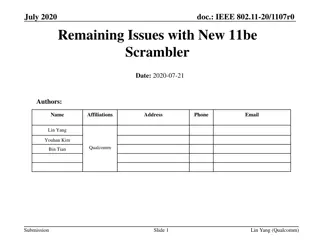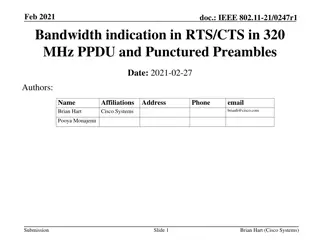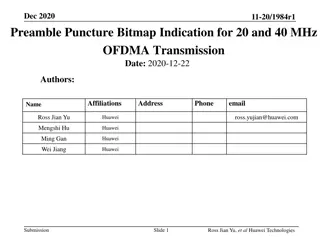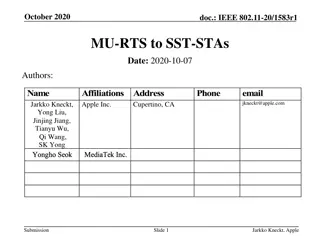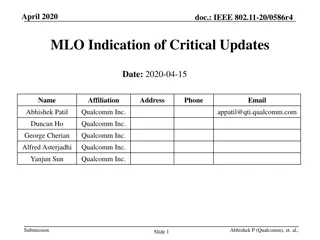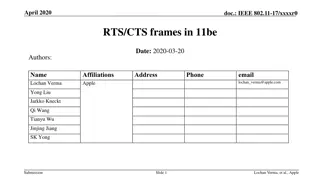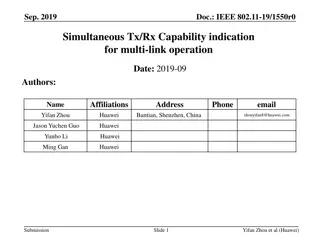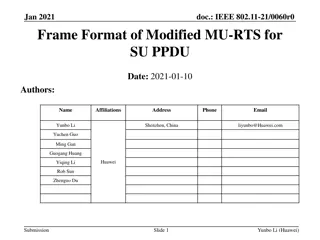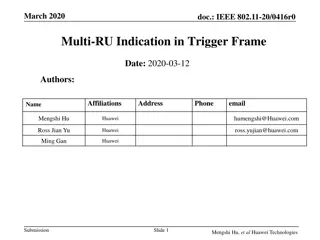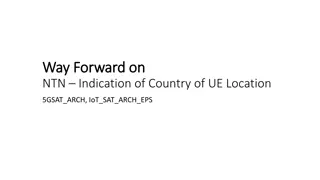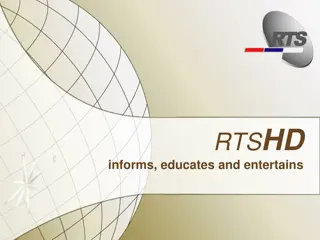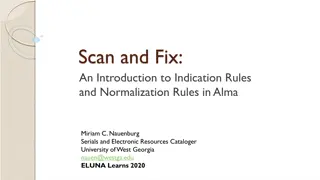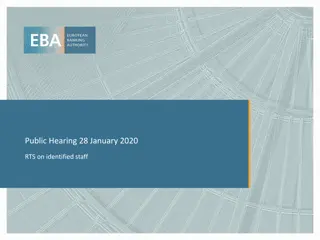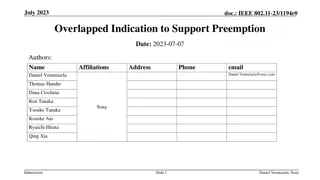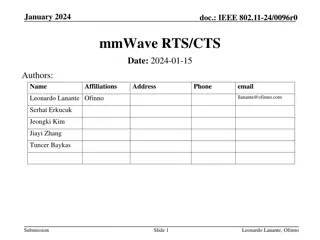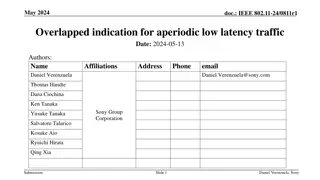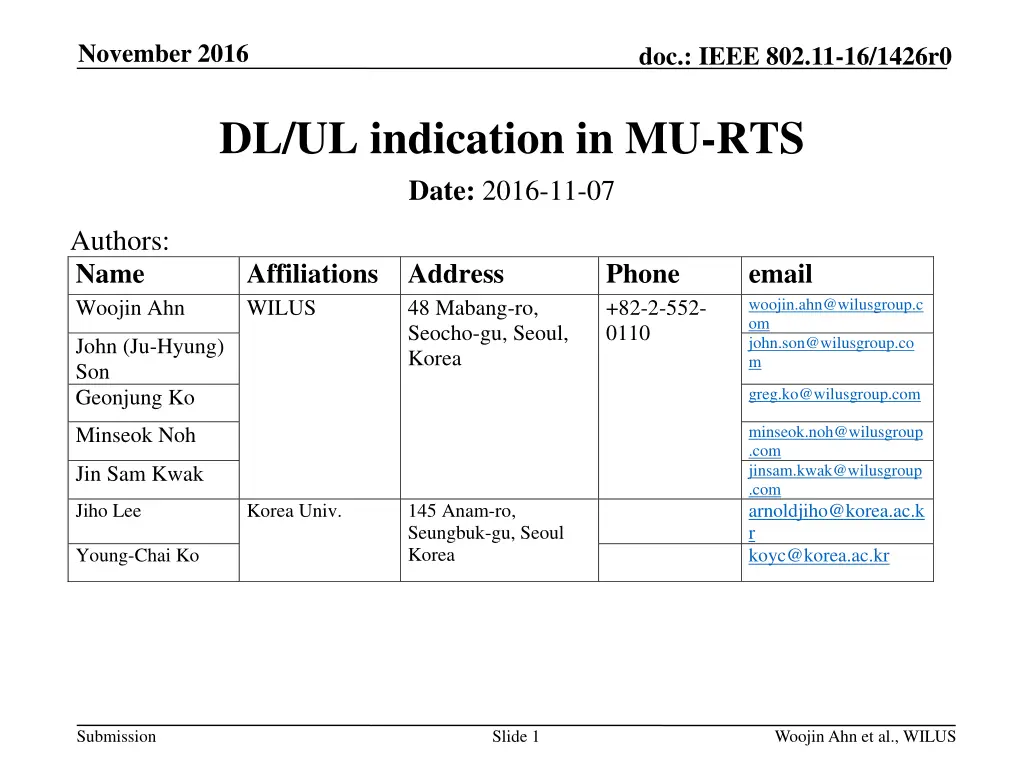
IEEE 802.11-16/1426r0 DL/UL Indication in MU-RTS Proposal
In this proposal, the authors discuss defining DL/UL indication in MU-RTS through a variant trigger frame using the Cascade Indication field. The document elaborates on the MU-RTS procedure for MU transmission, the use of Trigger frames to protect both DL and UL transmission, and the role of Cascade Indication in distinguishing DL and UL procedures. The authors suggest methods to ease processing load for UL STAs and enhance efficiency in MU-RTS operations.
Download Presentation

Please find below an Image/Link to download the presentation.
The content on the website is provided AS IS for your information and personal use only. It may not be sold, licensed, or shared on other websites without obtaining consent from the author. If you encounter any issues during the download, it is possible that the publisher has removed the file from their server.
You are allowed to download the files provided on this website for personal or commercial use, subject to the condition that they are used lawfully. All files are the property of their respective owners.
The content on the website is provided AS IS for your information and personal use only. It may not be sold, licensed, or shared on other websites without obtaining consent from the author.
E N D
Presentation Transcript
November 2016 doc.: IEEE 802.11-16/1426r0 DL/UL indication in MU-RTS Date: 2016-11-07 Authors: Name Woojin Ahn Affiliations Address WILUS Phone +82-2-552- 0110 email woojin.ahn@wilusgroup.c om john.son@wilusgroup.co m 48 Mabang-ro, Seocho-gu, Seoul, Korea John (Ju-Hyung) Son Geonjung Ko greg.ko@wilusgroup.com minseok.noh@wilusgroup .com jinsam.kwak@wilusgroup .com arnoldjiho@korea.ac.k r koyc@korea.ac.kr Minseok Noh Jin Sam Kwak Jiho Lee Korea Univ. 145 Anam-ro, Seungbuk-gu, Seoul Korea Young-Chai Ko Submission Slide 1 Woojin Ahn et al., WILUS
November 2016 doc.: IEEE 802.11-16/1426r0 Abstract In this contribution, we propose to define DL/UL indication in MU-RTS variant Trigger frame by using Cascade Indication field Submission Slide 2 Woojin Ahn et al., WILUS
November 2016 doc.: IEEE 802.11-16/1426r0 MU-RTS procedure for MU transmission AP may send MU-RTS variant Trigger frame to protect both DL and UL MU transmission In DL MU, HE MU PPDU follows right after simultaneous CTS In UL MU, another basic variant Trigger frame follows after simultaneous CTS In UL MU procedure, Trigger frame requires a large amount of processing load for UL STAs during SIFS CCA, A-MPDU packing within a given duration etc. Trigger frame MAC padding is proposed to allow additional processing time for UL STAs It is recommended to ease the processing load for STAs with low processing power AP AP MU- RTS MU- RTS DL ACK HE MU PPDU TF S- UL ACK S- HE TRIG PPDU CTS CTS STAs STAs Submission Slide 3 Woojin Ahn et al., WILUS
November 2016 doc.: IEEE 802.11-16/1426r0 Recap: Cascade Indication in Trigger frame Trigger frame contains Cascade Indication field 1-bit indication in common info field Indicating the presence of a subsequent trigger frame Currently used in a limited number of cases TWT operation, power save with UL OFDMA-based random access Reserved in other cases Submission Slide 4 Woojin Ahn et al., WILUS
November 2016 doc.: IEEE 802.11-16/1426r0 Exploiting Cascade Indication in MU-RTS In MU-RTS procedure of UL MU, a standalone basic variant Trigger frame always follows subsequently after simultaneous CTS No subsequent standalone Trigger frame for DL MU The Cascade Indication in MU-RTS can be used to distinguish whether the following procedure is DL MU or UL MU In case of UL MU, UL STA might prepare the UL MU transmission prior to the following basic-variant Trigger frame Submission Slide 5 Woojin Ahn et al., WILUS
November 2016 doc.: IEEE 802.11-16/1426r0 Advantages of DL/UL indication If the Cascade Indication subfield indicates the following procedure is UL MU; STAs solicited in the MU-RTS could have more additional time to prepare UL MU transmission STAs not supposed to participate in UL MU might get into sleep mode earlier E.g., UL MU disabled STAs, STAs with empty buffer Straightforward and aligned with the current usages Having the same meaning with other Cascade Indications Subsequent Trigger frame No ambiguity with other Cascade Indications MU-RTS is always used with UL/DL MU procedure Submission Slide 6 Woojin Ahn et al., WILUS
November 2016 doc.: IEEE 802.11-16/1426r0 Conclusion In this contribution, we have proposed to use the Cascade Indication in the MU-RTS variant Trigger frame as a DL/UL indication Submission Slide 7 Woojin Ahn et al., WILUS
November 2016 doc.: IEEE 802.11-16/1426r0 Strawpoll Do you agree to instruct TGax Editor to make the following change: TGax Editor: change the paragraph below of 9.3.1.23 (Trigger frame format) as follows: If the Cascade Indication subfield is 1, then a subsequent Trigger frame as defined in 10.3.2.8a.2 (MU-RTS procedure) and in 25.7 (TWT operation) and in 25.15.2 (Power save with UL OFDMA- based random access) follows the current Trigger frame. Otherwise the Cascade Indication subfield is 0. TGax Editor: insert the paragraph below of 9.3.1.23.4 (MU-RTS variant) as follows: The Cascade Indication subfield is set to 1 when the following procedure is UL MU and set to 0 when the following procedure is DL MU. Submission Slide 8 Woojin Ahn et al., WILUS




